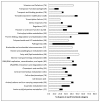The architecture and ppGpp-dependent expression of the primary transcriptome of Salmonella Typhimurium during invasion gene expression
- PMID: 22251276
- PMCID: PMC3293720
- DOI: 10.1186/1471-2164-13-25
The architecture and ppGpp-dependent expression of the primary transcriptome of Salmonella Typhimurium during invasion gene expression
Abstract
Background: Invasion of intestinal epithelial cells by Salmonella enterica serovar Typhimurium (S. Typhimurium) requires expression of the extracellular virulence gene expression programme (ST(EX)), activation of which is dependent on the signalling molecule guanosine tetraphosphate (ppGpp). Recently, next-generation transcriptomics (RNA-seq) has revealed the unexpected complexity of bacterial transcriptomes and in this report we use differential RNA sequencing (dRNA-seq) to define the high-resolution transcriptomic architecture of wild-type S. Typhimurium and a ppGpp null strain under growth conditions which model ST(EX). In doing so we show that ppGpp plays a much wider role in regulating the S. Typhimurium ST(EX) primary transcriptome than previously recognised.
Results: Here we report the precise mapping of transcriptional start sites (TSSs) for 78% of the S. Typhimurium open reading frames (ORFs). The TSS mapping enabled a genome-wide promoter analysis resulting in the prediction of 169 alternative sigma factor binding sites, and the prediction of the structure of 625 operons. We also report the discovery of 55 new candidate small RNAs (sRNAs) and 302 candidate antisense RNAs (asRNAs). We discovered 32 ppGpp-dependent alternative TSSs and determined the extent and level of ppGpp-dependent coding and non-coding transcription. We found that 34% and 20% of coding and non-coding RNA transcription respectively was ppGpp-dependent under these growth conditions, adding a further dimension to the role of this remarkable small regulatory molecule in enabling rapid adaptation to the infective environment.
Conclusions: The transcriptional architecture of S. Typhimurium and finer definition of the key role ppGpp plays in regulating Salmonella coding and non-coding transcription should promote the understanding of gene regulation in this important food borne pathogen and act as a resource for future research.
Figures








Similar articles
-
The primary transcriptome of Salmonella enterica Serovar Typhimurium and its dependence on ppGpp during late stationary phase.PLoS One. 2014 Mar 24;9(3):e92690. doi: 10.1371/journal.pone.0092690. eCollection 2014. PLoS One. 2014. PMID: 24664308 Free PMC article.
-
Genome-wide identification of transcriptional start sites in the haloarchaeon Haloferax volcanii based on differential RNA-Seq (dRNA-Seq).BMC Genomics. 2016 Aug 12;17(1):629. doi: 10.1186/s12864-016-2920-y. BMC Genomics. 2016. PMID: 27519343 Free PMC article.
-
Comparison of DeltarelA strains of Escherichia coli and Salmonella enterica serovar Typhimurium suggests a role for ppGpp in attenuation regulation of branched-chain amino acid biosynthesis.J Bacteriol. 2001 Nov;183(21):6184-96. doi: 10.1128/JB.183.21.6184-6196.2001. J Bacteriol. 2001. PMID: 11591661 Free PMC article.
-
The expanding targetome of small RNAs in Salmonella Typhimurium.Biochimie. 2017 Jun;137:69-77. doi: 10.1016/j.biochi.2017.03.005. Epub 2017 Mar 14. Biochimie. 2017. PMID: 28302471 Review.
-
sRNAs and the virulence of Salmonella enterica serovar Typhimurium.RNA Biol. 2012 Apr;9(4):437-45. doi: 10.4161/rna.20480. Epub 2012 Apr 1. RNA Biol. 2012. PMID: 22546935 Free PMC article. Review.
Cited by
-
S6:S18 ribosomal protein complex interacts with a structural motif present in its own mRNA.RNA. 2013 Oct;19(10):1341-8. doi: 10.1261/rna.038794.113. Epub 2013 Aug 26. RNA. 2013. PMID: 23980204 Free PMC article.
-
Promoter strength driving TetR determines the regulatory properties of Tet-controlled expression systems.PLoS One. 2012;7(7):e41620. doi: 10.1371/journal.pone.0041620. Epub 2012 Jul 27. PLoS One. 2012. PMID: 22848546 Free PMC article.
-
Transcriptional and Post-Transcriptional Modulation of SPI1 and SPI2 Expression by ppGpp, RpoS and DksA in Salmonella enterica sv Typhimurium.PLoS One. 2015 Jun 3;10(6):e0127523. doi: 10.1371/journal.pone.0127523. eCollection 2015. PLoS One. 2015. PMID: 26039089 Free PMC article.
-
A connecter-like factor, CacA, links RssB/RpoS and the CpxR/CpxA two-component system in Salmonella.BMC Microbiol. 2012 Oct 2;12:224. doi: 10.1186/1471-2180-12-224. BMC Microbiol. 2012. PMID: 23031642 Free PMC article.
-
Expanding the RpoS/σS-network by RNA sequencing and identification of σS-controlled small RNAs in Salmonella.PLoS One. 2014 May 8;9(5):e96918. doi: 10.1371/journal.pone.0096918. eCollection 2014. PLoS One. 2014. PMID: 24810289 Free PMC article.
References
-
- Chimalizeni Y, Kawaza K, Molyneux E. The epidemiology and management of non typhoidal Salmonella infections. Advances in experimental medicine and biology. pp. 33–46. - PubMed
-
- Cummings LA, Barrett SL, Wilkerson WD, Fellnerova I, Cookson BT. FliC-specific CD4+ T cell responses are restricted by bacterial regulation of antigen expression. J Immunol. 2005;174(12):7929–7938. - PubMed
-
- Thompson A, Rolfe MD, Lucchini S, Schwerk P, Hinton JC, Tedin K. The bacterial signal molecule, ppGpp, mediates the environmental regulation of both the invasion and intracellular virulence gene programs of Salmonella. J Biol Chem. 2006;281(40):30112–30121. doi: 10.1074/jbc.M605616200. - DOI - PubMed
Publication types
MeSH terms
Substances
Grants and funding
LinkOut - more resources
Full Text Sources
Other Literature Sources

